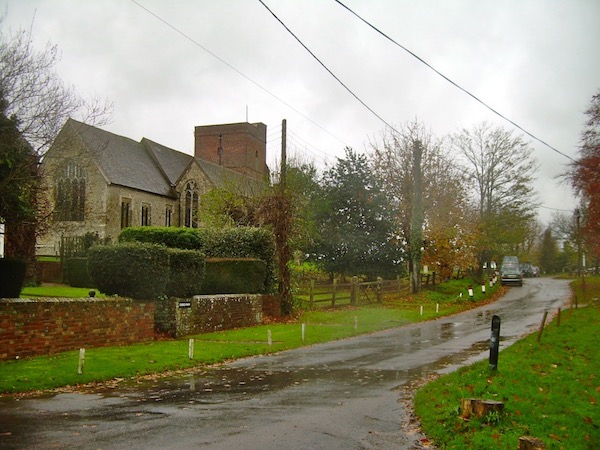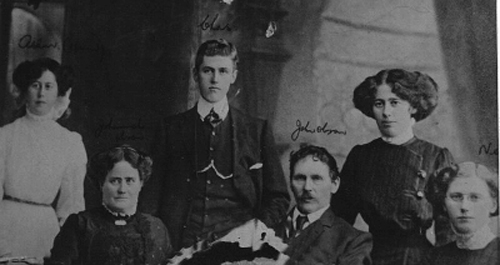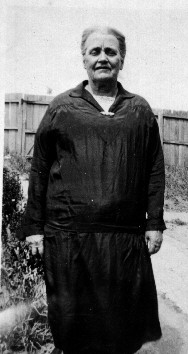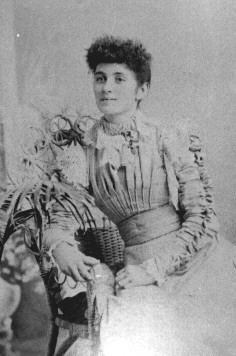
Another view of Warehorne
FOOTNOTES CHAPTER SEVEN
[1] Information originally obtained through by Phil Bensted of Mackay Queensland who in turn obtained it from a Richard Binstead of South Africa from research of parish and census records. I was put in touch with Phil by Andrea Fitzgerald whose husband Bernie is a descendant of Thomas and Bridget. Independently the information was confirmed by Steve Benstead of Aspendale, a descendant of Thomas and Hannah Benstead through their eldest daughter Jane. Much was also confirmed by my own research of parish records.
The other children of Thomas and Hannah all born in Warehorne were Jane (1815); Mary (1816); Anne (1817); James (1824); Sarah (1828) and Charlotte (1832)
The children of Thomas and Abigail christened at Warehorne were James (bap 11 Sep 1773) who later married a Martha Brenchley (his second wife, the name of his first wife is unknown) and was listed as farming 10 acres in the 1851 census; Anne (bap 6 Jul 1777); John (bap 20 Jul 1783) described as a farm labourer in the 1851 census at which time he was lodging with his brother Thomas; Thomas and Mary (bap 16 Jan 1791).
The other children of Thomas Russell and Sarah Horton were Ann (b 1751), Martha (b 1752) and Rebekah (b 1754).
Details of the marriage of Thomas and Hannah were originally supplied by Andrea Fitzgerald. All information re names and dates were also checked on the International Genealogical Index (IGI) and from online parish records. Nevertheless due to the incomplete nature of some parish records, the lack of detail in the information recorded in parish registers and the repetition of some names within families, some information needs to be treated with caution.

Another view of Warehorne
[2] The reference number of the document in the UK archives is ADM 101/49/9
Andrea Fitzgerald also located the convict records held in the Tasmanian State archives relating to Thomas, record No.16329. The records also record that he was a Protestant and able to read a little. His height was 5 feet 8 and 1/4 inches, he had a fresh complexion, an oval head, dark brown hair, whiskers and eyebrows, hazel eyes and a large nose with a medium mouth and chin. He had three small scars on the back of his right hand and a scar on the back of his left hand. His face was slightly pimpled.
Although the handwritten document is difficult to decipher it seems as if Romney and Clarence may have been places to which he was assigned, and there is clearly a reference to a Chas Reed of Longford on 10th Sep 1849. The record also states that his ticket of leave was revoked on 14th September 1852 due to his being absent from a muster, but restored two weeks later because his absence was accounted for. He was then approved for a conditional pardon on 16th Nov 1852, having served seven and a half years of his sentence.
In fact Caroline was not dead at the time of the marriage of Thomas to Bridget. In the 1851 census, Caroline was living with her parents and siblings in Great Chart. She is recorded as Caroline Bensted and described as married. By the time of the 1861 census however, she had reverted to her original name, Caroline Day, and gave her status as widow, presumably because she had come to the realisation that Thomas had either died or was was not returning. She subsequently married again in 1882 at the age of 64 to Charles Spearpoint, and died six years later. One wonders about the feelings and memories of each other that may have been retained by Thomas and Caroline. We will never know, but it is sad to think that Caroline may have waited in vain for more than ten years in the hope that Thomas would one day return after the completion of his sentence.
According to the 'NSW Museums of History' and 'Companion to Tasmanian History' websites, apparently it was not uncommon in the early years for convicts to marry again in the colony even though they had already been married prior to conviction. Some acted in the belief that their spouse was dead, others either thought they would never see their spouse again or believed incorrectly that transportation annulled marriage.
At the same time families of convicts sometimes accompanied their convict relations or came out later. A convict who had received his ticket-of-leave was entitled to apply to have his wife and family sent out at government expense. It was thought that such a scheme would help to redress the imbalance of gender in the colonies and provide an incentive to good behaviour among the male convicts.
Again it is impossible to know if Thomas was aware of this possibility, or if he was, why he did not apply.
[3] Information from Phil Benstead and Steve Bensted. The children of Thomas and Hannah were:- Jane (bap 13 Aug 1815); Mary (b 1816); Anne (b 1817); James (b 1824); Sarah (b 1828); Elizabeth (b 1831) and Charlotte (b 1832). Jane had an illegitimate daughter, Mary Ann bap 12 Mar 1837. She later married a James Austen. Steve Benstead is a descendant.
Death certificates of Thomas Sr and Hannah were supplied by Jill Bant another descendant of Thomas and Bridget.
The workhouses system in England evolved in order to provide for those unable to support themselves by offering accommodation and employment. They soon gained a grim reputation as life in a workhouse was intended to be harsh, to deter the able-bodied poor and to ensure that only the truly destitute would apply. Following the 1834 Amendments to the Poor Laws, individual parishes were formed into Poor Law Unions, each of which was to have a union workhouse. More than 500 were built during the next 50 years, two-thirds of them by 1840. Warehorne was one of the parishes served by the Willesborough workhouse. Applicants had to be assessed and approved for admission after which they were segregated according to age and gender. Initially it was hoped that work undertaken by the inmates would produce a profit for their workhouses, or at least allow them to be be self-supporting, but by the 1840's they largely housed only the incapable, elderly and sick.
There was a James Benstead and wife Susan residing at 6 Beaver Place, Ashford, Kent on the night of the 1881 census. He had been born in Warehorne in 1824. James occupation was "carpenter's labourer"
[4] Information held at PRO Melbourne. 1473/P No 3037
[5] A Thomas Benstead, farmer, of Curlewis is listed in the 1870 Victorian Postal Directory, but the entry is not repeated in later editions. The names and ages of eight children are recorded on Bridget's death certificate, they are Annie 29, John 28, Hannah 25, Thomas 21, Bridget 20, James 19, Patrick 17 and Catherine 14. Missing are Hannah whose date of death is unknown, Mary Ann who died in 1865 and Sarah who died in 1880 at the age of 19 (the death notice appeared in the "Geelong Advertiser" on Feb 23rd 1880). Honora who would have been 27 yrs is not listed but an Annie is listed whose age given as 29. I can only assume 'Annie' is actually Honora and her age is recorded incorrectly for some reason. On the death certificate of Thomas, all eleven children are listed and the ages of the eight living children correspond with their birth records.
I have been unable to find a death certificate for Hannah the first born of the family. John married Mary Cunningham in 1902 and died at Warragul in 1938. The couple appear not to have had any children. Further information about Johannah (Hannah) is recorded in footnote [21] below. Thomas married a Harriett Welsh in 1901 and fathered five children. He died at Fitzroy in 1940. Bridget married twice, first to Alf Hooper in 1886 by whom she had a daughter, and later to James Allison in 1899 by whom she had another daughter. Bridget died at Brunswick in 1933. James married Frances Bonnet in 1899 and the couple had at least five children. He died at Werribee in 1951. I have found no record of Patrick ever marrying and he died at Rochester (Vic) in 1935. Catherine married Robert Jarvis in 1894 and had at least 9 children. She died at South Yarra in 1949.
Mary Ann's death was the subject of an inquest which was reported in the 'Geelong Advertiser' of 29th April 1865. "An inquest was held yesterday, at Point Henry, by Forster Shaw Esq. M.D., coroner, on the body of Mary Anne Benstead, a child aged two years and ten months, who met her death by her clothes accidentally catching fire. From the evidence adduced, it '"appeared that on Tuesday last, between 3 and 4 o'clock p.m, deceased was left with her sister by her mother, who went to speak to neighbour, When the mother came back in about 10 minutes, she found the child with her clothes off in her father's arms, frightfully burned, She lingered till about-2 o'clock on Thursday, when she died. John Cooney stated that on Tuesday afternoon, whilst near Mrs Benstead's house, he heard a child screaming, and running in found the deceased all on fire. He tried to extinguish the flames with his hands, but being unable to do so pulled off all her clothes. The verdict of the jury was "Accidental Death." From the account it would seem that John Cooney was living in close proximity to his daughter and son-in-law and their family.
[6] Remark of Honora Benstead recalled by Theresa McFarlane. The cause of death recorded on the certificate was "carbuncle on the head, effusion on the brain". Perhaps Bridget had been ill for some time as her name was listed earlier as a patient at the Geelong hospital in a "Geelong Advertiser" report of March 23rd 1883. The burial service was conducted by a Catholic priest the Rev D Murphy.

The Olson family. Standing (l-r) are Annie, Charlie and Tilly. Nellie is seated front right with her parents Hannah (Benstead) and John Olson. (photo courtesy of Chris Upton)
[7] Details were obtained from the records of the Footscray cemetery. The Rev Fr English conducted the burial service for Thomas. Jill Bant organised the placing of a plaque on the grave in 2011.
John and Hannah Olson had four children:- Sarah Matilda (Tilly) (later Mrs Headland 1888-1964); Nellie Elizabeth (later Mrs Scanlon, 1889-1961); Charlie (b1890) and Annie May (later Mrs Upton, 1893-1977). Charlie was known by that name in his family and it is the name recorded on his birth certificate but in other records he is referred to as Charles.
John Olson died on July 27th 1932, aged 72 yrs. Hannah died on May 29th, 1946 aged 82 yrs. There is also a memorial on the grave to Charles Olson of the 29th Battalion AIF who died on Sept 6th 1918, aged 28 yrs, and who is buried in the Teheran War Cemetery in Iran.
Charlie Olson was a 25yr old blacksmith living with his parents at 26 Donald St Footscray at the time he enlisted on July 17th 1915. He was 5' 8" tall, 10 stone 7 lbs in weight with a chest measurement of 33/36 inches. He had a clear complexion, light blue eyes and brown hair with a scar on his right forearm. His religious denomination was recorded as Roman Catholic.
After some training in Australia he sailed for overseas in Nov 1915. He disembarked from the "Ascanius" at Suez on Dec 7th and joined the 29th Battalian at Tel-el-Kebir in March 1916. He contracted Enteric Fever and was pronounced dangerously ill at the end of March.
It was not until September of that year that he recovered sufficiently to be discharged from hospital. By this time the 29th Battalian had embarked for France and as part of the 5th Division took part in the battle of Fromelles (south of Armentieres) in July 1916. Probably Charles had rejoined his unit by the time it had been ordered south to the Somme in October. The 5th Division entered the front line on the night of Oct 21-22, just north of Gueudecourt, and thereafter shared responsibility for holding this section of the line south of Bapaume with the 2nd Australian Division. The 5th occupied the forward positions until Nov 5th and again from Nov 22nd till Dec 23rd.
In Feb of 1917 the Germans withdrew towards new defensive positions along the Hindenburg Line pursued by the British forces as they did so. As part of this operation the 8th AlF Brigade, of which the 29th Battalion formed part, carried out a successful attack on March 1st near le Transloy and captured "Sunray Trench", losing 60 men in the process.
The 8th Brigade continued to play an active part in the British advance towards Bapaume and was in fact the unit that occupied this strategic town on March 17th, against light German resistance. The British advance continued and the 29th occupied Beaumetz on March 21st, but before it could be relieved came under a fierce German counter-attack two days later.
Initially some of the positions held by the Australians were overrun and others had to be abandoned as the troops fell back towards Lebucquiere. However some positions held and the defenders were then able to launch their own counter-attack. Fierce fighting ensued (often involving bayonet tussles) and the Germans were pushed back. When Australian reinforcements were brought forward the former ground was largely recaptured.
The Australians lost a total of 12 killed and 38 wounded in the engagement with others captured whilst the Germans suffered 50 killed and 11 captured. The 29th was relieved that night and the 5th Division itself was relieved on April 6th. Shortly after this Charles Olson gained promotion to L/Corporal (April 1917).
Over the protests of its commanding officers who felt that their men had already been pushed to the limits of their endurance, the 5th division was ordered back to the front on May 8th and carried out the successful attack at Bullecourt on May 12th. The 29th Battalion was sent to the Lagincourt sector but seems to have escaped any fighting during this battle.
The Division finally was granted a well deserved break at the end of May, and retired to an area well to the rear near Amiens for four months complete rest before being ordered to Flanders in September. The 5th Division entered the front line in Flanders on the night of Sept 22-23 and took part in the attack on Polygon Wood and Zonnebeke on the 25th. The 8th Brigade played a significant part in this major battle and distinguished itself in the capture of Polygon Wood. In doing so however it lost a total of 12 officers and 292 men before being relieved between Sept 29th and Oct 1st.
The 5th Division was back in the line by Oct 12th but took no part in the unsuccessful attack on Passchendale which followed shortly afterwards. Charles Olson was promoted to Corporal in Oct 1917 and to Sergeant in Nov 1917. He was also mentioned in Routine Orders for gallant service rendered in Oct of 1917, presumably as part of the action at Polygon Wood.
Fighting subsided during the winter of 1917-1918 and by the time the 5th Division was again engaged in heavy fighting in March 1918, Charles Olson was far away.
In Jan 1918 a request was made for 12-20 officers of the A.l.F. to volunteer for a special assignment. Those finally selected were to be the "cream of the cream" of the Australian forces. On Jan 10th a further request was made for 20 N.C.O's of similar qualities. Sgt Charles Olson volunteered, was selected, and by Jan 20th found himself in London along with other volunteers drawn from the various allied forces.
By Jan 29th he was on his way across France and Italy to Taranto, from where he sailed for Alexandria. From there he travelled by way of Suez and Kuwait to Basra which he reached on March 4th. By March 28th he was camped at Hinaidi outside Bagdhad as part of a special unit under the command of Major-General Dunsterville known as "Dunsterforce".
The objective of "Dunsterforce" was to block the threatened Turkish advance towards India and the Anglo-Persian oilfields at the head of the Persian Gulf by rallying the remnants of the Russian forces that were still willing to fight (the Bolsheviks had triumphed in the Russian Revolution in Nov 1917 and concluded an Armistice with Germany) together with the Christian Assyrians, Armenians and Georgians who had fought alongside the Russians and who were expected to want to continue to resist as they had much to fear from the Turks. (The later massacre of the Armenians at the hands of the Turks demonstrated that their fears were well founded.)
Dunsterville himself arrived in Mesopotamia in Jan 1918, two months before his main force, established his HQ. at Hamadan, and set about winning over the local Persian population and organizing the defences. The main body of "Dunsterforce" marched overland to Hamadan in several groups with those containing the Australians reaching there on May 18th and May 25th. They were not opposed on the march, although it was a difficult journey through territory inhabited by armed groups of uncertain allegiance.
Some members of "Dunsterforce" (including Dunsterville himself,) left shortly afterwards for Baku to organize resistance to the threatened Turkish advance into the Caucasus. (This proved an impossible task and Baku eventually fell on Sept 12th). At the same time other elements of the force were deployed to Zenjan, Bijar and Sehneh to guard the "Persian Road". Yet other elements of the force were involved in an heroic rearguard action when the Armenian forces opposing the Turks at Urmia collapsed in August precipitating a flight of 80,000 civilians towards Bijar. Only 50,000 eventually made it, the rest being massacred by the pursuing Turks or killed by marauding bands of robbers and deserters. The fleeing troops were eventually reorganized by members of "Dunsterforce" and by the time of the signing of the Armistice in Nov 1918, were preparing to advance and retake Urmia.
By this time however Sgt Charles Olson was dead. He had died of malaria at Hamadan on Sept 6th 1918, one of only two casualties suffered by the Australian members of "Dunsterforce". (All details above obtained from "The Official History of Australia in the War of 1914-1918" by C.E.W.Bean and from Charles Olson's own army record)
Charles Olsen was remembered in the Last Post Ceremony presented in the Commemorative area of the Australian War Memorial on 30th October 2015. The text of the address and a video of the ceremony can be viewed at the Australian War Memorial website
[8] Some details supplied by Theresa McFarlane, other details were obtained from the death certificates of both John and Honorah which were supplied by Mrs Jessie Tillack of Birregurra, a descendant of John and Honorah. The details regarding the marriage of John and Honorah were also obtained through Jessie Tillack.


Honora Benstead (left) and her daughter Bridget Berry
GO TO CHAPTER EIGHT
RETURN TO CONTENTS PAGE